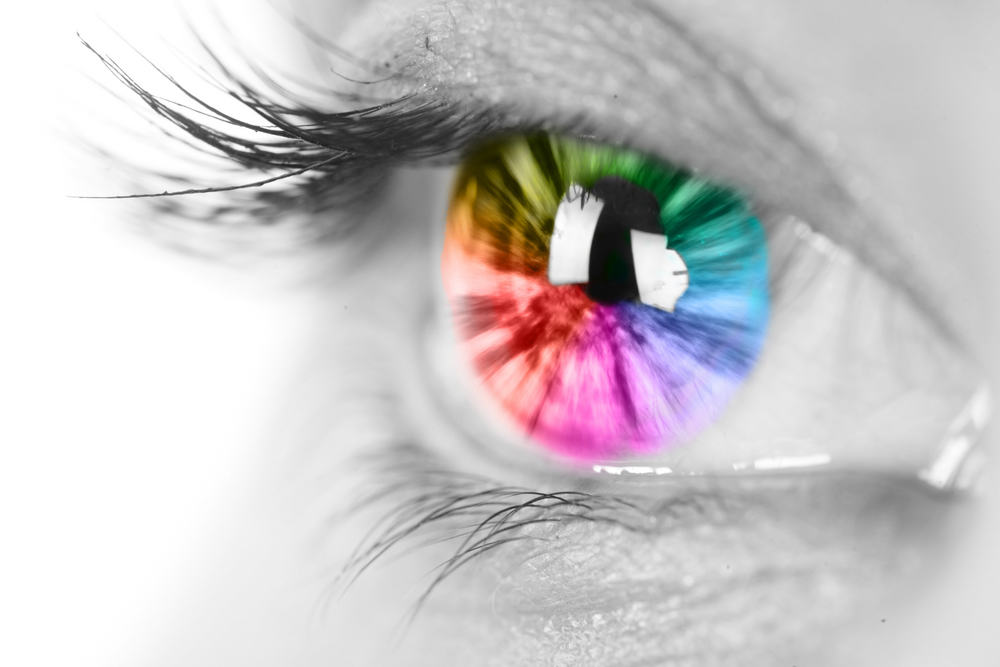Do you or does someone you know have different-colored eyes? When you meet someone with one blue and one brown eye, for example, it sometimes takes a minute to register why they may seem a little “not quite right.” But then, when you look a little closer, you see how beautiful and unique this trait is. It’s a rare phenomenon called heterochromia. So is it always DNA-caused or can it happen for other reasons? Let’s have a look.
 Where Eye Color Comes From
Where Eye Color Comes From
First, a little bit about eye color. A pigment called melanin determines hue, and eye color develops in the eight or so weeks following birth.
- People with a lot of melanin in their irises have brown eyes.
- People with very little melanin in their irises have blue or grey eyes.
- People with middling amounts of melanin sport hazel or green eyes.
Newborns’ eyes all look blue because it takes weeks for the genetically-designated amount of melanin to ‘color in’ their irises. Today’s scientists believe that two genes control eye color (not just one), and it is how these genes interact that provides the full range of colors in people’s peepers. Which brings us to folks who have two different-colored eyes.
FUN FACT: Did you know that blue eyes were originally caused by a genetic mutation some 6,000 to 10,000 years ago? Scientists believe that everyone originally had brown eyes. That original mutation ended up greatly affecting the world’s DNA pool, didn’t it? READ MORE ABOUT IT HERE.
Different Types of Heterochromia
‘Heterochromia’ is a Latin term meaning ‘different colors,’ which perfectly describes this trait. There are actually three distinct categories of heterochromia, although some people may have a combination of two or three:
- Complete (each eye is a different color).
- Sectoral (a segment of one or both irises is a different color).
- Central (a different color surrounds the pupil).
How Does Heterochromia Happen and Why?
There are lots of different reasons! In the vast majority of cases, people are born with different-colored eyes, but there are times when heterochromia is caused by something else. Do you or someone you know have different-colored eyes? If so, this unique characteristic most likely happened from one of the reasons listed below.
Family DNA: Usually, if the trait is apparent from babyhood, then it came from the family gene pool. In fact, since it’s a dominant autosomal trait, chances are good one of the person’s parents has it too.
Trauma during Birth: If facial trauma occurs around the time birth, it may prevent melanin from ‘coloring’ the eye in the affected area of the face.
Genetic Mutation: Sometimes, a mutation in one of the genes regulating eye color may occur during embryonic development.
Disease: There are certain diseases such as Horner Syndrome that may cause heterochromia during a person’s lifetime.
Injury: Heterochromia that happens later in life is usually caused by eye injuries or specific types of medication.
Chimera: Under extremely rare circumstances, a person could be a chimera (when they contain separate DNA from an undeveloped twin) and have eyes with different colors as a result.
The Bottom Line
Keep in mind that traits like heterochromia or other physical characteristics are never absolute proof of paternity-a DNA paternity test is a much more scientific and reliable resource for determining a biological relationship. Too often, a mother might say, “But my child looks just like this man I slept with and not like the other one,” only to find out through DNA testing that the child is the biological offspring of the man he/she looks nothing like! So be very careful about making assumptions about a biological relationship based only on heterochromia.
Our bodies are wonderful things, and little blips in our DNA can sometimes have physical consequences-like double eyelashes! Over time, genetic mutations are no longer mutations at all, but are considered ‘normal’-like blue eyes. If you or someone you know is lucky enough to have different-colored eyes, embrace its unique look!
Follow us on Facebook and Twitter! If you have questions about paternity tests or other DNA testing services, please contact our Client Support Center at 888-404-4363, Mon-Fri from 9 AM to 6 PM Eastern Time. Our friendly, expert representatives are ready and happy to help. Get answers anytime by visiting our Help Center.
Sources
Alle. “7 Beautiful Mutations: Which Ones Do You Have?” XoVain. Time, Inc., 3 Oct. 2013. Web. 07 July 2016. <http://www.xovain.com/how-to/7-beautiful-mutations-which-ones-do-you-have>.
Bryner, Jeanna. “One Common Ancestor Behind Blue Eyes.” LiveScience. TechMedia Network, 31 Jan. 2008. Web. 07 July 2016. <http://www.livescience.com/9578-common-ancestor-blue-eyes.html>.
Gross, Susan J. “How Does Someone Get Two Different-colored Eyes?”Scientific American. Nature America, Inc., 3 Nov. 2001. Web. 07 July 2016. <http://www.scientificamerican.com/article/how-does-someone-get-two/>.
Heiting, Gary, OD. “Why Do Some People Have Two Different Colored Eyes?”All About Vision. Access Media Group, LLC., Apr. 2016. Web. 07 July 2016. <http://www.allaboutvision.com/conditions/heterochromia.htm>.
Melina, Remy. “Why Do Some People Have Differently Colored Eyes?”LiveScience. TechMedia Network, 25 Jan. 2011. Web. 07 July 2016. <http://www.livescience.com/32954-why-do-some-people-have-differently-colored-eyes.html>.









